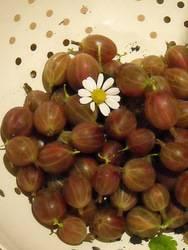A quick guide to identifying some hedgerow fruit
Posted by Fiona Nevile in Hedgerow food | 79 commentsPhoto: Wild cherry plums
I’ve had quite a few emails recently about identifying hedgerow fruit so I thought that it might be helpful to post some of the pictures that I have. Sloes, wild damsons, wild cherry plums and bullaces all came from the same family – albeit distant relations. They all have stones and the bushes have similar leaves.
Photo: Sloe on a branch
The main problem seems to be differentiating sloes and wild damsons as they are both small and dark. Sloe bushes have sharp thorns and wild damson trees do not. Damsons have longer stems so hang and look more like a tiny plum. Sloes have shorter stems and hug the branches more.
Steve pointed out (see comments) that sloes can be confused with Deadly Nightshade – you can see some photos Deadly Nightshade photos here.
Wild plums taste like domestic plums (from sharp Mirabelles to sweet Victorias). Wild bullaces taste like greengages. Wild damsons are very sharp and sloes taste almost bitter.

Photo: Wild plums and bullace
Of course the best pocket guide to hedgerow foraging is Richard Maybe’s Food for Free (Collins GEM). It’s now on offer on Amazon for under £3.00.
Leave a reply






Having picked bucketfulls of cherry plums from my garden hedge this year,apart from stewing them can a jam be made?
Yes there’s one here on the site
http://www.cottagesmallholder.com/two-wild-plum-jam-recipes-38
I would strongly argue that Richard Maybe guide to food for free is simply an exploratory delve into a mostly unknown treasure trove.
For instance i see no mention in this book or even Roger Phillips’ wild food book of the pre-flowering stems of Cow Parsley, Anthriscus sylvestris also known as wild chervil. These stems, once the outer peel has been removed (easily by teeth, fingernails or knife) are eaten raw or could be ever so lightly blanched or steamed. The taste is a cross between a carrot and mild fennel. Base and middle note flavours rather than top notes. Gorgeous. Thankyou to Robin Harford of eatweeds for showing me that.
found some green sweet fruits and can only describe them as greengages but wild so have look onto your sigh to give answers , the tree is about 20 ft high and we picked 1lb 10 oz as some have already dropped the tree is only about 6 inches in diameter and we have never seen the fruits here before they are very lovely
I too picked fruit exactly how you describe, aprilbell29. Not sure what to do with the 2lb I picked…
Hi there – I am new to picking. I think I have found sloes but I am very confused by the conflicting information on the internet. The fruit I have found are small, have a stone inside, the leaves and description match that of a sloe and when i bit it it dried my whole and was bitter….but the branches have no thorns…can anyone help? could these still be sloes even without the thorns? Any guidance would be very very much appreciated 🙂 Thanks in advance…
The sure fire way to identify a plant unknown to you is to use plant identification book or key. For plant identification in Britain I would recommend “The Wildflower Key” by Rose and O’Reilly. As plant descriptions are detailed you would be able to use the rule on the back of the book and instantly see the difference in leaf size between deadly nightshade, damsons and sloes, also note that damsons and sloes are small trees that have woody branches while deadly nightshade is herbaceous. Foraging guides are good for letting you know what part of something is edible when, and unless you know the plant are best accompanied by a more technical plant identification book.
Hi Guys
great advice on the plums/cherries. We have a tree on our road with the plum/cherry next to the 10p piece. We thought they were damsons. Here’s a fab recipe we made up using them.
250 g stoned and skinned plums including the juice(drop into boiled water and the skins slip off)
6 eggs
225g caster sugar
250g ground almonds
skin stones as described above saving juice
beat eggs and sugar until fluffy
add almonds and beat
add plums and beat.
pour into greased and lined spring from cake tin
into oven 200 degrees centigrade for 50 minute or until knife comes out clean
watch point: cover with greased paper when skin forms on runny mixture or it will burn – mixture is very runny, but it comes out beautifully
A few years ago my best friend made me some cranberry gin for Christmas, I would love to return the gesture with some sloe gin. I have recently moved to Norfolk and keep coming across buses full of what I think are sloes. However, I’m very scared of mixing them up with either deadly nightshade or some other poisonous fruit – apparently that is the biggest cause of poisoning in Europe. Can anyone recommend a sure fire way to for me to identify sloes?
Some bullaces are like greengages, others are more like larger sloes.
Tasting them helps ID them. If they make your mouth dry up instantly with the sheer sour flavour, they are sloes. If they are still fairly not-nice to eat, but not that bad, they are black bullaces. If they are intense, but nice, they are wild damsons.
Hi Roger
Taste the damson gin. If it’s too sweet halve the gin and sugar bit and add more damsons, gin and no sugar. Keep on doing this until it tastes right.
Great that you are enjoying the site.